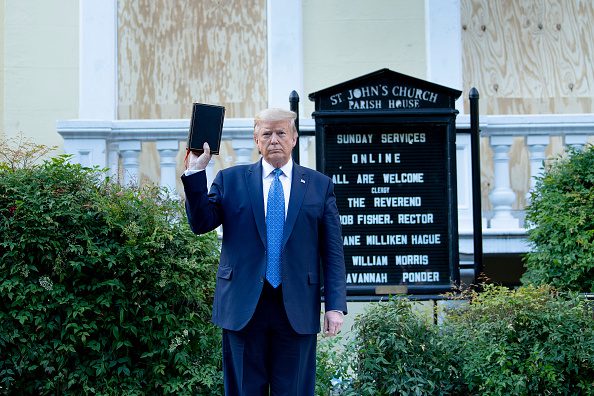Trump’s ‘Photo Op’ at Lafayette Square is Another Media Flop

As protests over the death of George Floyd consumed the nation last June, then-President Donald Trump was widely criticized by media, elected officials, and even former military leaders for a photo op at St. John’s Episcopal Church in Lafayette Square, where he had gone to observe damage done to the church by the ongoing protests. The condemnation was based on Trump’s allegedly ordering law enforcement to clear the area using pepper spray, tear gas, and explosives while arresting protesters who refused to vacate the premises.
The Atlantic called the order a “grotesque violation of the First Amendment” while the New York Times blamed the president for causing a “burst of violence unlike any seen in the shadow of the White House in generations.” The day was hailed as one of the defining moments of Trump’s presidency, polarizing the country further as civil unrest was unfolding.
But none of that was true.
A Department of the Interior Inspector General report released Wednesday revealed that Lafayette Square was cleared not for a Trump photo op, but for a planned installation of security fencing. The U.S. Park Police and Secret Service concluded that the area needed to be cleared for the fencing to be safely installed. The Inspector General report notes:
The evidence we obtained did not support a finding that the USPP cleared the park to allow the President to survey the damage and walk to St. John’s Church. Instead, the evidence we reviewed showed that the USPP cleared the park to allow the contractor to safely install the antiscale fencing in response to destruction of property and injury to officers occurring on May 30 and 31. Further, the evidence showed that the USPP did not know about the President’s potential movement until mid- to late afternoon on June 1—hours after it had begun developing its operational plan and the fencing contractor had arrived in the park.
In the media’s desperation to frame President Trump as the man responsible for violently suppressing [mostly] peaceful protests, investigation and fact-checking were replaced with a narrative. The optics made Trump look bad, which meant that there was an opportunity to magnify the incident. Subsequent lawsuits fueled the fire, as the media contrasted peaceful protests and civil liberties organizations against the aggressive and unapologetic Trump administration.
The Interior’s I.G. report comes over a year after the incident, but shines light on how determined media actors were to castigate Trump given the slightest opening. NBC News correspondent Ken Dilanian reflected on the revelation, saying “a narrative we thought we knew is not the reality.” If Dilanian and others were to apply that understanding to various other narratives they hold near and dear, they may be surprised by how much reality conflicts with today’s journalism.
Michael Huling is a graduate student at the Pepperdine University School of Public Policy and an editorial intern for The American Conservative.
Comments